|
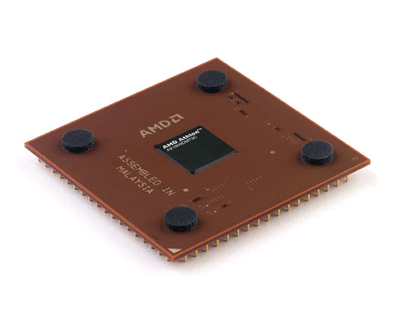
Introduction
Another few weeks roll by and AMD release the next iteration of their new AthlonXP processor line, the XP2000. If you cast your mind back to our review of the Athlon XP1900 we commented that it was the fastest x86 processor that money could buy but the price was very high compared to the XP1700 for only a 66Mhz increase in CPU speed.
Is this processor more of the same? Another huge price hike over the XP1800 for only a few more Mhz? It was early November when we saw the XP1900 debut with 1600Mhz of the quickest x86 processor money could buy. In the few weeks that have passed, Intel have been static and the competition from Intel in the x86 market is just the same. The 2.0Ghz Intel Pentium 4 processor is still Intel's most powerful x86 consumer processor, just like it was when the XP1800 was released.
So is it just a forgone conclusion that the XP2000 increases the lead that AMD have in the XP1900? Before we answer the questions surrounding this new processor, lets take a look under the hood. Being an AthlonXP processor it again features AMD's QuantiSpeed core enhancements. QuantiSpeed is made up of 4 improvements to the old Thunderbird processor core that stopped with the 1400Mhz.
- Enhancement to the CPU pipeline, increasing IPC (Instructions Per Clock)
- Floating point unit enhancements to make it the quickest ever x86 FPU
- Hardware data prefetch meaning the CPU is intelligent enough to guess what data it might need next
- Modifications to the Transition Lookaside Buffers for better use of on chip L1 and L2 cache memory
QuantiSpeed is what allows AMD to use it's new XP ratings on these new processors. The XP rating is based on the speed that an equivalent Thunderbird core processor would need to be at to provide comparable performance. In the case of the XP1500 which runs at 1333Mhz, you would need a 1.5Ghz Thunderbird Athlon to provide the same performance. In this case with the 1666Mhz XP2000 you would need a Thunderbird core Athlon clocked to 2GHz to provide the same performance.
The processor runs on the same 133Mhz Front Side Bus as the rest of the range meaning usage of a 12.5x multiplier is needed. This caused a few initial problems on the Abit KR7A motherboard used to test the processor. The KR7A with both 5G and 6B BIOS's dont natively detect the XP2000 and in both BIOS's the 12.5 multiplier isn't selectable. It took a few boots and CMOS clears to deduce that the 13x multiplier choice in the BIOS gave us the 12.5x we needed. Abit have confirmed a BIOS update will be needed to support the XP2000 processor.
With 13x multiplier selected in the BIOS the processor booted fine as an Athlon XP 1664Mhz Processor. So onto the performance benchmarks.
Performance
First up, the test system.
- AMD Athlon XP2000+ Processor
- Abit KR7A-RAID (VIA KT266A)
- 256Mb Crucial PC2100 DDR
- Gainward Ti550 GeForce3
- Adaptec 39160 Dual Channel U160 SCSI 64-bit PCI Controller
- 2 x 73Gb Seagate Cheetah U160 10,000rpm disks
- Plextor 12/10/32S SCSI CDRW
- Creative Soundblaster Audigy Player
- Netgear FA310TX PCI NIC
The test software consists of SiSoftware Sandra 2002.0.8.57 and 3DMark 2001 both running on Windows XP Professional (Build 2600.xpclient.010817-1148). Drivers wise the test system used the Detonator 22.40 drivers for the graphics card and the latest Audigy drivers from europe.creative.com. All other drivers were the XP drivers provided by the OS.
Sandra CPU Arithmetic Benchmark

Sandra CPU Multimedia Benchmark
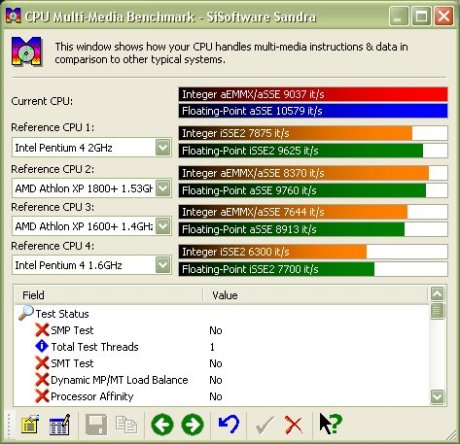
As you can see, according to Sandra, we have the quickest stock clocked x86 processor that money can buy, at least in Sandra's theoretical benchmarks. The FPU performance is eclipsed only in the arithmetic test by a 2Ghz P4 utilising SSE2 instructions and even then, not by much.
Sandra Memory Bandwidth Benchmark

We can see from the screenshot that the KT266A chipset on the KR7A is giving us slightly higher numbers that expected at 133Mhz FSB. I suspect the reference numbers were gleaned from a Thunderbird processor on the chipset or the KR7A has some extra memory controller tweaks enabled upon boot by the BIOS. Crucial PC2100 CAS2.5 memory was used and besides the CAS value set to 2 manually, all other settings were stock. We can see that the XP processor and VIA's current flagship AMD chipset are a good match as far as Sandra is concerned. Both processor and chipset are the fastest items currently available at the time of writing and are the quickest stock AMD benchmarks yet seen at Hexus as we'd expect.
As we can see, the XP2000 is an incremental upgrade over the XP1900 performance wise, performing extremely well out of the box. It further increases the XP1900's lead over the Intel 2Ghz Pentium 4 when paired with a fast DDR chipset as our memory benchmark with the KT266A chipset on the KR7A shows. The low latency of DDR SDRAM helps close the absolute memory bandwidth gap with PC800 RDRAM and the i850 chipset as used with high end Pentium 4 solutions, although P4 DDR solutions are appearing on the market providing low latency memory subsystems for the Pentium 4.
However, at the moment the XP2000 has no peers at the top of the x86 performance tree, bar its younger sibling the XP1900.
Overclocking
Being a new processor it's nice to see how the higher yields used to create these new processors are helping the enthusiast overclock them. As AMD get increasingly better yields it stands to reason, unless they are getting close to the limits of the process, that the overclocking ceiling should get a little higher with each new processor.
Overclocking the XP2000 wasn't like overclocking all the previous AthlonXP's and Thunderbird core processors I've ever had in that it didn't respond well to voltage increases. Running the processor at 1.85V yielded little improvement in final stable clock speed than the standard 1.75V. Usually being able to the give the processor some extra voltage gets you that little bit further.
In this case the highest stable speed I encountered with the XP2000 with the KR7A-RAID motherboard was 12.5 x 144Mhz or 1.8Ghz and this was with 1.75V (stock voltage). Here's a WCPUID shot for proof with benchmarks to follow.
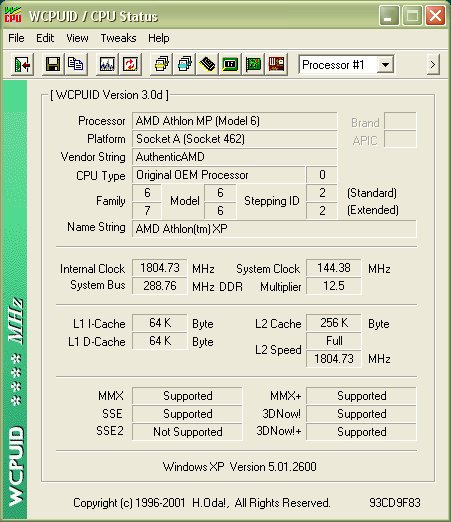
Sandra CPU Arithmetic Benchmark
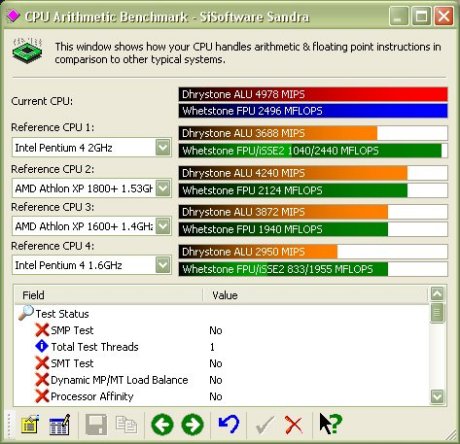
Sandra CPU Multimedia Benchmark
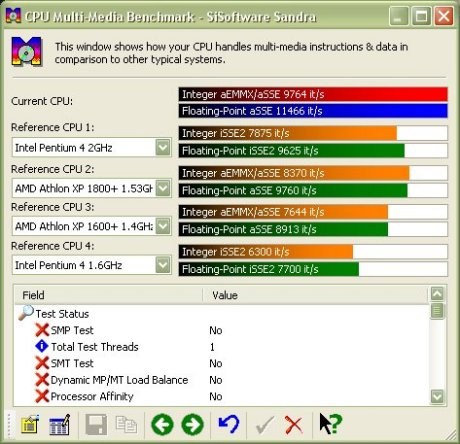
As we can see the overclocked XP2000 is the fastest CPU we've yet ran in a review system at Hexus. The 1800Mhz pure clock gives the quickest Arithmetic Benchmark results yet seen and even beats the 2Ghz P4 in raw FPU power, despite the P4 using it's speedy SSE2 instructions in the reference numbers. The Multi-Media benchmark is more of the same with the processor showing a huge lead over the next quickest reference processor the Athlon XP1800 and also Intel flagship opponent the 2Ghz Pentium 4. While these are only theoretical benchmarks from Sandra they are valid benchmarks and most often (but not always) correlate to a real world performance lead over a similar, out of the box, reference system.
Sandra Memory Bandwidth Benchmark
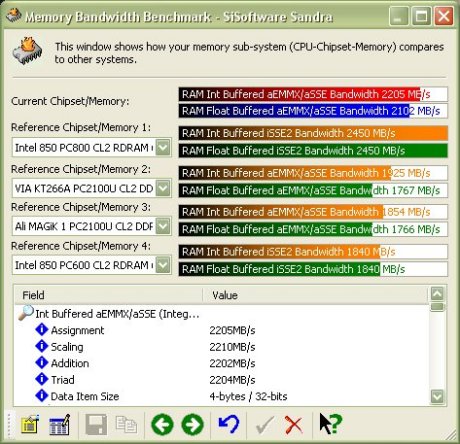
The 144Mhz FSB gives us an approximate 200Mb/sec increase in both the integer and floating point tests that make up the benchmark. We can see the processor and the KT266A chipset are working well here and they are a good match. Pairing the processor with a fast DDR chipset is a must to get the most from the processor. While it's possible to run this processor on some late revision KT133A boards (rev 1.2+ IWill KK266's and some rev 1.3 Abit KT7A's) it's not worth it from a performance point of view and is somewhat comparable to running a 2Ghz P4 processor on an i845 SDR SDRAM motherboard (although we did just that in recent reviews!) since you are crippling the processor. The faster they get the more processors crave information being fed to them.
There is no point using a super fast processor and not backing it up with a high performance memory subsystem. The CPU would sit idle for countless clock cycles while it waited for the memory controller to pass it the next bit of data it required. Likewise feeding the memory controller information when writing back to memory. You don't want to be waiting while the controller writes out to system memory and tell you it's ok to feed it more. This is why a high performance memory subsystem is essential to the current crop of huge performance x86 processors.
In DDR memory the processor has access to low latency main memory. This means that the data is available in as few clock cycles as possible. During any memory request there are obvious delays while the memory controller finds the correct section of memory to read from and then it must be passed to the processor. All of those operations takes valuable clock cycles. DDR memory has a significantly shorter latency that RAMBUS RDRAM (at current memory speeds at least) so it can pass the data to the host processor as quick as possible, then be fast enough to continue a stream of memory or find the next section to transfer (in the case of random memory I/O, the normal pattern in a desktop computer system, although that's changing).
Finally, as a somewhat abstract indication of the performance of the processor when overclocked, here's a 3DMark 2001 result from this current system. The processor was at 144 x 12.5 with stock voltage (1.75V), memory at 144Mhz CAS2 2-5-2, 4-way. 1T command decode. The GeForce3 Ti550 was clocked to 265/565 and 3DMark 2001 was run fully tweaked with manipulated Level Of Detail and Frame Pre-render settings using the 22.40 DetonatorXP drivers and RivaTuner RC7 for the tweaking. Finally, WindowsXP was the operating system.
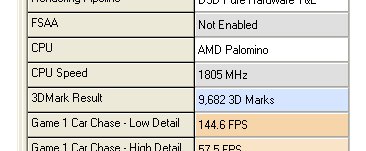
You can also find the current compare URL here (http://gamershq.madonion.com/compare2k1.shtml?2267315). It's a full test and my current highest entry on the MadOnion ORB. For your information the processor at the same clocks has given me non full test results in the 97xx range (the 'politics' of those competing for the higher scores in the ORB mean that only full tests are usually submitted and accepted) which under Windows 98 would correspond to 99xx range scores (run Windows 98, pass go, collect 200+ points!) and a possible shot at 10,000. There is more to come from the graphics card and some more on the CPU (another 50Mhz at a push on this motherboard) so 10,000 would be on.
This is the first processor to get me into that range of scores and a 99xx score would give Team Hexus the current lead at the Fastest Webmaster competition at MadOnion.
While the benchmark is a fully tweaked out standard bench with the driver manipulated between each game test for maximum performance and points, it is an indication of what the processor can help a complete performance system achieve.
The performance of the processor when overclocked was strange however in that extra voltage didn't seem to help at all. Maybe it's a BIOS issue since the BIOS clearly doesn't know about the processor yet ,although monitoring the voltages in Motherboard Monitor indicated that what I was setting in the BIOS was being reported, at least by the monitoring hardware. It will be nice to obtain a more permanent review processor since this press CPU must be returned ultimately to AMD and explore the overclocking options of a different processor to see if the same holds true.
Conclusion
It's fairly obvious we have here the quickest x86 processor that money can buy. Paired with DDR SDRAM on a high bandwidth chipset like the VIA KT266A on the Abit KR7A-RAID host motherboard it offers the fastest consumer computing platform in the world as I type this.
However, like all nice things, the performance comes at a price. At the time of writing the processor was yet to be launched by AMD. Some sites are taking pre-orders for the processor at a staggering £308. That's an incredible amount of money for a processor when almost all XP processors from XP1500 (make sure you get a good week!) to XP1800 will do 1666Mhz without that much difficulty.
It's hard to justify £300+ for a processor when my own XP1500 that does 1.8Ghz (week 43 for those looking to try and get a monster overclocker like mine) only cost around £110, just over a third of the price. Granted my CPU is handpicked from a small batch but most will hit the 1.6Ghz+ range and it makes it hard to tell people to buy an XP2000 at £300+.
Again, like we concluded in the XP1900 review, the processor can only be recommended to upgraders with deep pockets or for inclusion in a full system that might swallow up some of the cost. The upside is the high price is that the other CPU's should receive a price drop which can't be bad. Whereas you might have been aiming for an XP1700 in your budget, price cuts might hopefully bring an XP1800 within reach.
For sure it's the fastest consumer processor that money can buy, but at the moment it's for people with deep pockets only. People looking to purchase AMD are wise to wait for this processors release and see if price cuts on the rest of the range take effect.
Incredibly fast and incredibly expensive are the buzzwords to take away from this review when thinking about this processor.
|